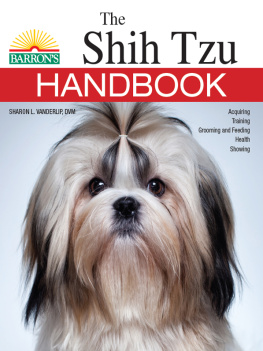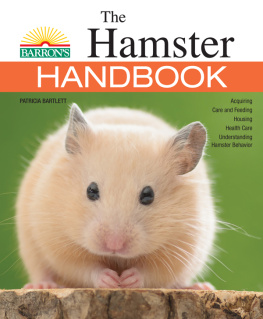

Copyright 2014, 2004 by Barrons Educational Series, Inc.
All rights reserved.
No part of this publication may be reproduced or distributed in any form or by any means without the written permission of the copyright owner.
All inquiries should be addressed to:
Barrons Educational Series, Inc.
250 Wireless Boulevard
Hauppauge, New York 11788
www.barronseduc.com
eISBN: 978-1-4380-9282-9
Please be advised that certain pages, illustrations, tables, graphs, etc. may look different depending on what type of device you are using to view this eBook. Please adjust your device accordingly.
Acknowledgments
I would like to thank my husband, Jack Vanderlip, D.V.M., for his invaluable help as an expert consultant, his thoughts and ideas, and for reviewing the manuscript. Thanks to our daughter, Jacquelynn, for taking care of the animals at home, so I would have more time to write. Thank you to Dr. Dan Rice for his excellent evaluation and helpful suggestions.
About the Author
Sharon Vanderlip, D.V.M., has provided veterinary care to domestic and exotic animal species for more than 35 years. She has authored several books on dog breeds and animal care and published numerous articles for scientific, veterinary, and general reading audiences.
Dr. Vanderlip served as the Associate Director of Veterinary Services for the University of California at San Diego School of Medicine and collaborated on reproductive research projects with the Zoological Society of San Diego. She is former Chief of Veterinary Services for the National Aeronautics and Space Administration (NASA), and is a consultant in reproductive medicine and surgery for various research and wildlife projects. Her practice focuses on canine reproductive medicine. She has lectured at kennel clubs and veterinary associations throughout the United States and Europe on topics in canine and exotic animal medicine and is the recipient of various awards for her writing and dedication to animal health. Doctor Vanderlip may be scheduled for seminars at www.sharonvanderlip.com.
Cover Photos
Shutterstock:
Antonio Guillem: spine
chaoss: front cover, inside back cover
Liliya Kulianionak: inside front cover
Nagel Photography: back cover (top)
WilleeCole Photography: back cover (bottom)
Photo Credits
iStockphoto:
S5iztok:
Shutterstock:
chaoss:
Darren K. Fisher:
Eric Isselee:
Erik Lam:
Jagodka:
Liliya Kulianionak:
Nagel Photography:
Picture-Pets:
Roman Zhuraviev:
siamionau pavel:
Smart-foto:
Svetlana Valoueva:
WilleeCole Photography:
Margery Squier:
Contents

Shih Tzu History
Your fortune cookie reads There is a Shih Tzu in your life. Could it be true? Remember the first time you ever saw a Shih Tzu? You were captivated. And now you cant stop thinking about this remarkable little dog. You wonder, Who is this charismatic canine with the beautiful flowing coat and an aura of magic? Even its name sounds exotic! The Shih Tzuwhat does it mean? And where does it come from? Could this be the perfect dog for me?
We are about to begin a fascinating journey that will answer those questions and many more. You will learn what you want to know about the Shih Tzu and discover the qualities and characteristics of this unique breed. So let your imagination run free as we step back in time to faraway places and ancient civilizations. Slip back into hidden valleys and remote, misty mountains to find the imperial palaces of China and the religious temples of Tibet. There, more than 3,000 years ago, at the foot of religious leaders, Buddhist monks, and powerful rulers, proudly sat the ancestors of todays Shih Tzu.
The Shih Tzu (pronounced sheed zoo ) is a charming, intelligent, regal little dog. It may be small in stature, but it never fails to make a big impression on everyone it meets. With its winning personality, luxurious coat, and elegant demeanor, this attractive canine draws admirers wherever it goes. And Shih Tzu are just the right size, too. At only 9 to 10 inches (22.8 to 25.4 cm) high at the shoulder and weighing only 9 to 16 pounds (4 to 7.2 kg), Shih Tzu fit in every home and on every lap.
Shih Tzu means lion in Chinese. For several hundreds of years, many Asiatic dogs were bred to resemble small lions. Lion dogs were small and bearded, had round heads, flat faces, short noses, large round eyes, square bodies, and short legs. Lions held great significance in the Buddhist religion. They were considered the sacred beasts of Buddha and it was said that Buddha tamed a lion and rode it. Legend also said a lion followed Buddha everywhere. In the same manner, it was said that lion dogs followed in Buddhas footsteps and it was believed that lion dogs housed the spirits of Buddhist monks.
Today the white blaze on a Shih Tzus forehead is called the Star of Buddha and the dark markings across the back are said to resemble the saddle Buddha used to ride a lion. Through the years, dedicated Shih Tzu breeders have done their best to follow the Shih Tzu ideal standard to keep the breed similar in size and appearance to the treasured lion dogs of ancient times.
There are hundreds of breeds of dogs and every one of them, including the Shih Tzu, traces back to the same prehistoric carnivorous (meat-eating) relative, a creature called Hesperocyonines. The fossil record tells us that Hesperocyonines evolved in North America about 40 million years ago and resembled a cross between a weasel and a fox. Before Hesperocyonines became extinct 15 million years ago, it gave rise to various canine species.
During the next several million years, many canine species became extinct, such as the dire wolves (Canis dirus) , large wolves that lived in North America during the Pleistocene era and died out as recently as 10,000 years ago. However, there are 35 living species of canids that still exist today (including foxes, wolves, coyotes, jackals, and dogs). All of these species originated and evolved in North America and all are distant descendants of Hesperocyonines.
Approximately 7 million years ago many canid species migrated from North America to Asia. One theory is that this migration was facilitated by a land bridge that may have existed during that era. This was a time before dogs, as we know them, existed. Of course, no human was there to document the migration or to record how the different species continued to evolve, but we do know that the Shih Tzus remote ancestors were among them. The Shih Tzus sweet expression and gentle demeanor belie the fact that, like all members of the domestic dog species (known as Canis familiaris ), the Shih Tzu is a direct descendant of the gray wolf and shares 98.2 percent of its genetic material in common with this very close wild ancestor.
Dogs were the first animals to be domesticated by humans, although precisely when and where remain topics of lively debate. Archaeologists contend that the fossil evidence places canine evolution somewhere between 13,000 and 20,000 years ago, most likely when wolves became scavengers around human campsites and settlements. A study of mitochondrial DNA sequences (genetic material that remains relatively unchanged through maternal lineage) suggests domestication may have occurred 100,000 years ago, but not all scientists are in agreement. Some researchers accept a time range of 40,000 years, which falls somewhere between the fossil and genetic data.
Next page












